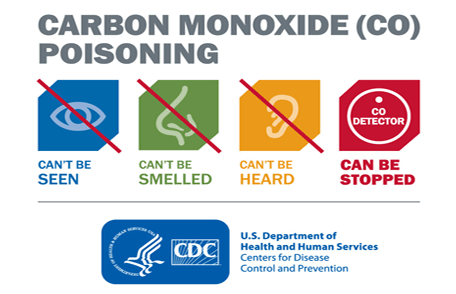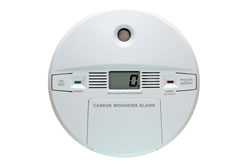Prevent Carbon Monoxide (CO) Poisoning
 Daylight Savings Time begins Sunday, March 12, 2017. As you prepare to set your clocks ahead one hour, remember to check the batteries in your carbon monoxide (CO) detector. If you don’t have a battery-powered or battery back-up CO alarm, now is a great time to buy one. About 400 people die each year in the United States from unintentional, non-fire related CO poisoning.
Daylight Savings Time begins Sunday, March 12, 2017. As you prepare to set your clocks ahead one hour, remember to check the batteries in your carbon monoxide (CO) detector. If you don’t have a battery-powered or battery back-up CO alarm, now is a great time to buy one. About 400 people die each year in the United States from unintentional, non-fire related CO poisoning.
CO is found in fumes produced by furnaces, vehicles, portable generators, stoves, lanterns, gas ranges, or burning charcoal or wood. CO from these sources can build up in enclosed or partially enclosed spaces. People and animals in these spaces can be poisoned and can die from breathing CO.
When power outages occur during emergencies such as hurricanes or winter storms, the use of alternative sources of power for heating, cooling, or cooking can cause CO to build up in a home, garage, or camper and to poison the people and animals inside.
Install a battery-operated or battery back-up CO detector in your home and check the batteries when you set your clocks forward one hour.

Spring ahead by installing a battery-operated or battery back-up CO detector in your home or by checking the batteries, if you already have one, as you set your clocks ahead one hour.
You Can Prevent Carbon Monoxide Exposure
Do
- Have your heating system, water heater and any other gas, oil, or coal burning appliances serviced by a qualified technician every year.
- Install a battery-operated or battery back-up CO detector in your home and check or replace the battery when you change the time on your clocks each spring and fall.
- Leave your home immediately and call 911 if your CO detector ever sounds. Seek prompt medical attention if you suspect CO poisoning and are feeling dizzy, light-headed, or nauseated.
Don’t
- Run a car or truck inside a garage attached to your house, even if you leave the door open.
- Burn anything in a stove or fireplace that isn’t vented.
- Heat your house with a gas oven.
- Use a generator, charcoal grill, camp stove, or other gasoline or charcoal-burning device inside your home, basement, or garage or outside less than 20 feet from a window, door, or vent.
CO poisoning is entirely preventable. You can protect yourself and your family by acting wisely in case of a power outage and learning the symptoms of CO poisoning.
Click here for important CO poisoning prevention tips in 16 additional languages.
For more information, please visit cdc.gov/co.
- Page last reviewed: March 6, 2017
- Page last updated: March 6, 2017
- Content source:
- National Center for Environmental Health, Division of Environmental Hazards and Health Effects, Air Pollution & Respiratory Health Branch
- Page maintained by: Office of the Associate Director for Communication, Digital Media Branch, Division of Public Affairs




 ShareCompartir
ShareCompartir